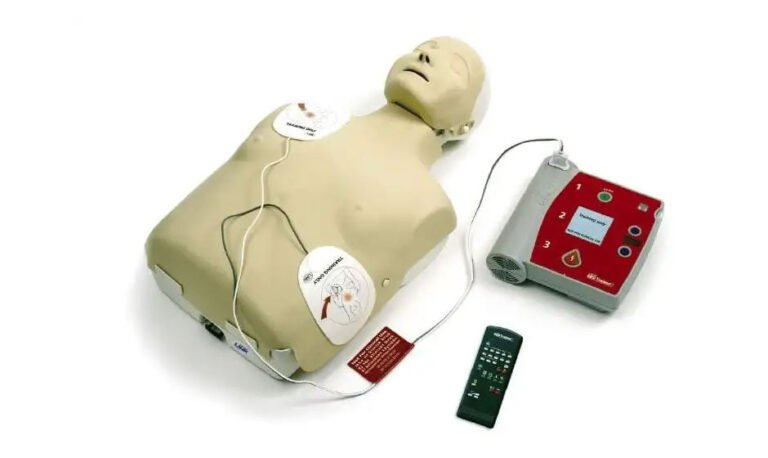The need for an Automated External Defibrillator (AED) depends on your situation and location. AEDs are portable devices that analyze and, if needed, shock the heart to restore a normal rhythm during sudden cardiac arrest. This life-saving tool is essential in emergencies, as cardiac arrest can strike anyone, regardless of age or health. Access to AEDs in public spaces and knowing how to use them can make a critical difference in saving lives.
Understanding Sudden Cardiac Arrest
The Silent Killer: Sudden Cardiac Arrest
Sudden Cardiac Arrest is often misunderstood and confused with a heart attack, but they are two distinct medical events. While a heart attack involves a blockage in one or more of the coronary arteries, causing damage to the heart muscle, SCA occurs when the heart’s electrical system goes awry, leading to a chaotic heartbeat or ventricular fibrillation.
Rapid Onset and Deadly Consequences
“Sudden” cardiac arrest is no exaggeration—it can strike without warning, catching victims off guard. During SCA, blood flow to vital organs, including the brain, is severely compromised. Immediate treatment is essential to prevent irreversible brain damage or death within minutes.
Survival Rates and the Importance of Prompt Action
The survival rates for SCA are grim without timely intervention. When defibrillation is administered within the first few minutes of cardiac arrest, the chances of survival can increase significantly. This is where Automated External Defibrillators (AEDs) come into play.
How Do Automated External Defibrillators (AEDs) Work?
Here, we will explore how AEDs work and their importance in emergency situations.
The Basics of AED Operation
- Safety First:
Before rushing to aid someone in cardiac arrest, prioritize safety for both yourself and the victim. Take a moment to assess the scene for potential hazards like electrical wires, water, or flammable materials. Your quick safety check ensures you can provide effective assistance without putting anyone in additional danger. Remember, a safe environment is the foundation for effective life-saving actions.
- Retrieve the AED:
Act swiftly to locate the nearest AED and bring it to the victim’s side. In public spaces like airports, malls, and schools, AEDs are often conveniently placed for easy access. Having the AED within reach is essential for initiating life-saving measures during a cardiac arrest emergency.
- Attach the Electrode Pads:
Most AEDs come with adhesive electrode pads that have pictures or instructions on where to place them. Typically, there are two pads—one on the upper right chest and the other on the lower left side of the chest. Peel off the backing and place the pads as directed.
- Analyze Heart Rhythm:
The AED takes charge of automatically analyzing the victim’s heart rhythm through the electrode pads. It’s elemental to ensure that no one is touching the victim during this critical process. Allowing the AED to work without interference aids in accurately assessing the situation and determining the appropriate course of action for resuscitation.
- Shock Advised:
If the AED detects a shockable rhythm, it will provide clear instructions to stand clear and not touch the victim while it delivers the shock. Ensure that no one is touching the victim or any wet surfaces.
- Deliver the Shock:
After giving the “shock advised” prompt, the AED will deliver a controlled electric shock. Some AEDs will require you to press a shock button, while others will automatically deliver the shock. Make sure nobody is touching the victim before pressing the button or allowing the AED to deliver the shock.
- CPR:
After the shock is delivered, immediately begin cardiopulmonary resuscitation (CPR). Follow the AED’s voice prompts or the recommended CPR guidelines for your region, typically involving chest compressions and rescue breaths.
- Continue CPR and Follow AED Prompts:
The AED will continue to monitor the victim’s heart rhythm and provide prompts for further shocks or CPR cycles until emergency medical personnel arrive or the victim shows signs of recovery.
The Importance of AED Accessibility
1. Early Defibrillation Saves Lives:
The most critical factor in increasing survival rates for SCA is early defibrillation. Every minute that passes without defibrillation reduces the chances of survival by approximately 7-10%. This underscores the importance of having AEDs readily accessible in public places, workplaces, and homes.
2. AEDs in Public Spaces:
In numerous countries and regions, the importance of AEDs in public spaces has been widely acknowledged, leading to the implementation of laws or regulations mandating their installation in specific locations. These designated areas often encompass airports, shopping malls, schools, sports facilities, and government buildings. The presence of AEDs in such accessible venues plays a vital role in improving response times and survival rates during cardiac emergencies.
3. Workplace AED Programs:
Employers in an AED company have a responsibility to provide a safe working environment for their employees. Implementing a workplace AED program not only demonstrates a commitment to employee well-being but can also save lives in the event of cardiac emergencies at the workplace.


